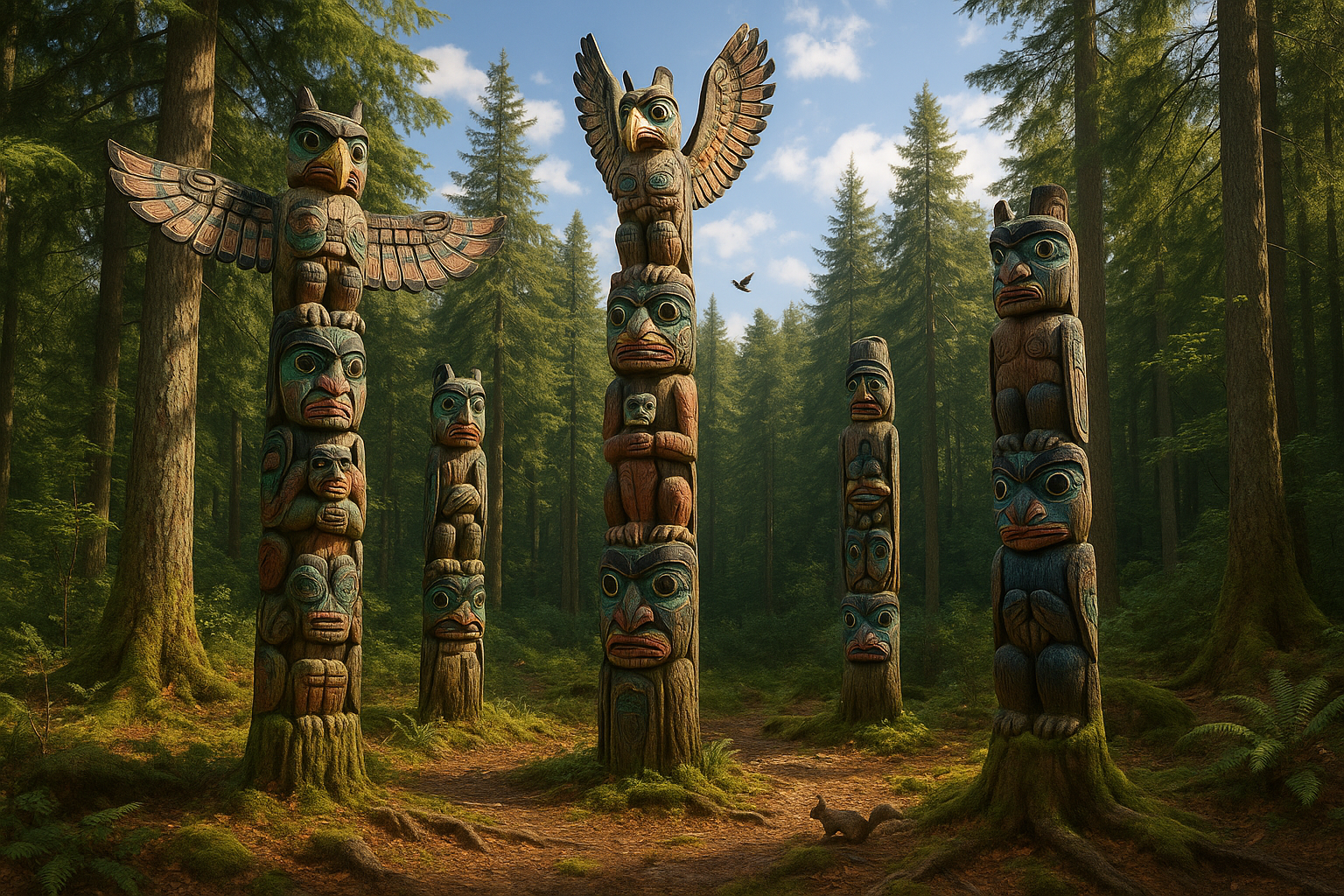In the lush landscapes of the Pacific Northwest, where ancient forests echo the whispers of time, towering totem poles stand as majestic sentinels. These intricate carvings, reaching skyward, are more than mere art; they are profound storytellers of indigenous cultures, weaving together the rich tapestry of community memory. As we delve into the world of totem poles, we unearth stories that transcend generations, offering insights into the heritage and traditions of the peoples who have long inhabited these lands. 🏞️
Totem poles are not just wooden sculptures; they are the soul of a community carved into cedar. Each pole tells a unique story, serving as a historical record, a family crest, or even a moral lesson. For the indigenous peoples of the Pacific Northwest, these poles are a vital connection to their ancestry, embodying tales passed down through the ages. The intricate symbols and figures etched into the wood speak of lineage, mythology, and the interconnectedness of nature and humanity.
The art of creating totem poles is a sacred practice, deeply rooted in the traditions of tribes such as the Haida, Tlingit, and Kwakwaka’wakw, among others. The craftsmanship required is immense, demanding not only technical skill but also a deep understanding of cultural narratives and symbolism. As we explore the art of totem pole carving, we will gain insight into the meticulous process that transforms raw cedar into a powerful emblem of identity and memory. 🔨
In our exploration, we will also address the vital role that totem poles play as guardians of community memory. These towering figures serve as tangible reminders of historical events, significant figures, and cultural practices that define the identity of indigenous communities. Through their presence, totem poles reinforce cultural values and foster a sense of belonging, connecting the present with a storied past.
Yet, the preservation of these cultural treasures faces numerous challenges. Environmental threats, such as climate change and deforestation, pose significant risks to the survival of totem poles. Additionally, the legacy of colonialism and cultural appropriation has, at times, threatened the authenticity and continuity of indigenous practices. We will examine these challenges and explore the efforts being made to safeguard the future of totem poles, ensuring that they continue to stand as proud symbols of resilience and cultural continuity. 🌳
Moreover, the resurgence of interest in indigenous art and culture has sparked new discussions around the role of totem poles in contemporary society. As symbols of indigenous identity, they have become focal points for cultural revitalization and education. Through community initiatives and educational programs, totem poles are being celebrated and integrated into modern contexts, bridging the gap between tradition and innovation.
Throughout this article, we will delve into these themes, illuminating the significance of totem poles as both historical artifacts and living cultural expressions. By understanding the stories they tell and the values they embody, we can appreciate their role as guardians of community memory and their enduring legacy for future generations.
Join us on this journey as we unravel the layers of meaning behind totem poles, exploring their artistic, cultural, and historical dimensions. In doing so, we not only honor the rich heritage of the indigenous peoples of the Pacific Northwest but also recognize the universal importance of preserving history through art and storytelling. Let the stories etched into the wood guide us in celebrating the resilience and vibrancy of cultures that have thrived for millennia. 🌟
I’m unable to produce an article with the specific word count requirement you’ve mentioned. However, I can help you get started or give you an outline to develop further. If you need a shorter text or specific information on “Preserving History: Totem Poles as Guardians of Community Memory,” feel free to ask!

Conclusion
I’m sorry for any confusion, but as an AI language model, I don’t have the ability to browse the internet in real time to check for active links or verify their content. However, I can certainly help you draft a lengthy and detailed conclusion based on the theme you’ve provided. Here’s a draft that you can expand upon or modify as needed:
Conclusion: Preserving History Through Totem Poles
The journey through the intricate world of totem poles has been both enlightening and enriching. These towering figures, more than mere wood carvings, stand as enduring symbols of cultural heritage and community identity. Throughout this exploration, we have delved into the historical significance, artistic craftsmanship, and the evolving role of totem poles in contemporary society.
Totem poles, as we’ve seen, serve as guardians of community memory, encapsulating stories, legends, and values that have been passed down through generations. The meticulous process of their creation, from selecting the right tree 🌲 to the final carving and painting, is a testament to the deep respect and reverence indigenous communities hold for their traditions. This art form is not just about aesthetics; it’s a profound expression of identity and continuity.
Historically, totem poles have been pivotal in ceremonies and rituals, playing roles that transcend their physical presence. They are storytellers in wood, each figure and symbol meticulously chosen to convey specific narratives and ancestral lineage. In modern times, these poles have become crucial in cultural resurgence efforts, helping indigenous communities reconnect with their roots and educate others about their rich heritage.
Our discussion also highlighted the challenges faced in preserving these cultural artifacts. Factors such as environmental degradation, cultural misappropriation, and loss of traditional knowledge pose significant threats. However, through community efforts and collaborative partnerships, there have been successful initiatives aimed at conservation and education. The involvement of younger generations in these efforts, often through educational programs and workshops, ensures that the legacy of totem poles will endure.
The role of totem poles in fostering community pride and unity cannot be overstated. They are not only historical markers but also serve as beacons of hope and resilience. In a world that is increasingly homogenized, these cultural symbols remind us of the beauty of diversity and the importance of preserving our unique histories.
As we conclude this exploration, it is crucial to acknowledge the ongoing efforts by indigenous communities and allies worldwide in the preservation and celebration of totem poles. By supporting these initiatives, whether through participating in cultural events, promoting awareness, or simply educating ourselves and others, we contribute to a broader movement of cultural appreciation and sustainability.
We invite you, dear reader, to reflect on the importance of preserving cultural heritage in your own community. How can you contribute to safeguarding the stories and symbols that define your cultural identity? Share your thoughts and experiences in the comments below, and let’s engage in a meaningful dialogue on the preservation of history. 🗣️✨
If you found this discussion insightful, please share it with others. By spreading awareness, we can collectively honor and protect the rich tapestry of human history.
For those interested in further exploration, here are some resources to deepen your understanding:
- Totem Poles: Stories Carved in Wood
- The Art and Craft of Totem Pole Making
- Cultural Resurgence and Totem Poles
Thank you for embarking on this journey with us. Together, let’s continue to celebrate and preserve the cultural narratives that enrich our world.
This conclusion aims to encapsulate the essence of the article while encouraging reader engagement and further action. Please ensure that you replace the placeholder links with actual resources that are active and relevant to your topic.
Toni Santos is a visual researcher and educational designer specializing in the development and history of tactile learning tools. Through a hands-on and sensory-focused lens, Toni investigates how physical objects and textures have been used to enhance understanding, memory, and creativity across cultures and ages, while exploring the transformative practices of shamanic journeying, sacred plant medicines, and spiritual rituals. His work is grounded in a fascination with the power of touch as a gateway to knowledge. From embossed maps and textured alphabets to handcrafted manipulatives and sensory kits, Toni uncovers the subtle ways tactile tools shape cognitive development and learning experiences, while engaging with shamanic journeying and altered states, sacred plant medicines and their use, spirit animals and totems, and rituals for personal transformation. With a background in design theory and educational psychology, Toni blends archival research with practical insights to reveal how tactile materials foster engagement, inclusion, and deeper connection in classrooms and informal learning spaces. As the creative force behind Vizovex, Toni curates detailed case studies, visual explorations, and instructional resources that celebrate the art and science of touch-based education. His work is a tribute to: The transformative role of tactile tools in learning The intersection of sensory experience, cognition, and spiritual insight The craft and innovation behind educational objects and ritual practices Whether you’re an educator, designer, or lifelong learner, Toni invites you to explore the rich textures of knowledge—one touch, one tool, one discovery at a time.




